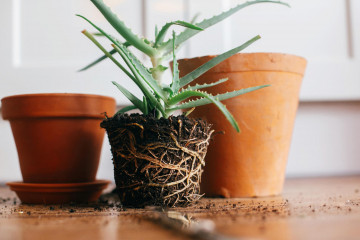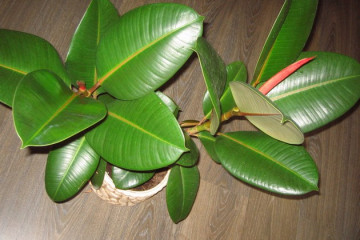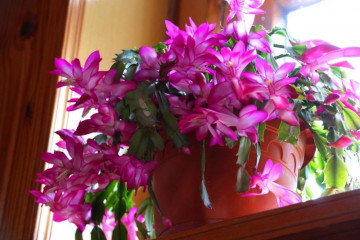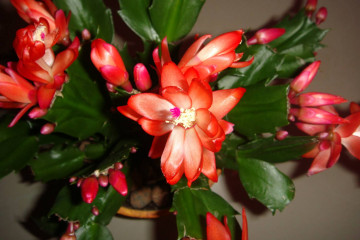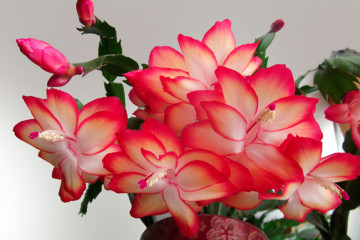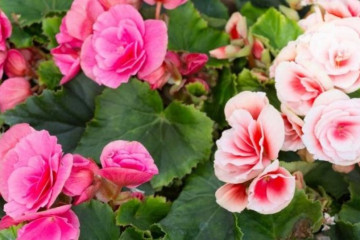How to transplant a Decembrist at home into a new pot
Content:
The Decembrist has another name - Schlumberger's zygocactus. This species is one of the varieties of forest cacti, belongs to epiphytic plants. The indoor flower has been considered a symbol of winter for many years. The flowering of the plant most often begins in December, just in time for the New Year holidays. But in order for the zygocactus to always please with the most beautiful flowers, you need to know when to transplant the Decembrist and how to do it correctly.
When a transplant is needed
At home, you can decide when you need to transplant a Decembrist by the following factors:
- Flower transplant immediately after purchase. Florists are advised to immediately change not only the shipping pot, but also the ground. Most often, flower shops use peat as soil. If you do not change the substrate in a timely manner, the plant will begin to wither and ache.
- Strong growth of the root system. The roots not only appear on the surface of the soil, but also grow through the drainage holes. These signs indicate an urgent need to transplant the Decembrist into a larger pot.
- Rotting roots. Due to improper care, the roots of the plant can begin to rot. In this case, experienced flower lovers recommend replanting indoor plants in a new container with simultaneous recovery.
How often to transplant the Decembrist
A young plant must be replanted at least once a year or as the root system grows.
The transplant of a Decembrist adult should be carried out once every 3 years.
How to choose a pot and soil
Before transplanting, it is important to decide which pot is needed for the Decembrist flower. Due to the pickiness of the plant, the container can be made of almost any material.
Experienced growers advise using the following types of pots:
- ceramic (any plant will respond to natural material with gratitude);
- clay (a huge variety of pots made of clay will not leave anyone indifferent);
- glass (new - pots made of glass allow you to monitor the state of the root system);
- wooden boxes (most often used to breed a large number of flowers at the same time);
- plastic vases (a good alternative cheap material with a wide range of shapes and colors).
For transplanting this particular plant, experts advise purchasing soil intended for succulents and cacti. Alternatively, you can make the earthen mixture yourself.
To prepare a suitable substrate, you must take:
- 2 parts sifted sand;
- 1 piece of leafy land;
- 1 part peat or moss;
- 1 part of expanded clay.
Soil disinfection
To destroy pests and possible fungi, the soil must first be disinfected. The procedure can be carried out in several ways:
- early watering of the soil with a weak solution of potassium permanganate;
- calcining the earth in high temperature conditions, for example, in an oven;
- preliminary spillage of the substrate with Baikal.
Preparing for transplant
How to transplant a Decembrist flower into another pot? You must first perform a series of step-by-step actions:
- Choose a pot that is age appropriate and has drainage holes required. The container for the Decembrist should be neither deep nor wide. With excess space, the root system and leaves "fatten". Flowering is impossible in this case.
- Fill the container 1/3 with drainage consisting of expanded clay, pebbles or broken bricks. The drainage layer allows you to drain water in a timely manner and prevents the roots from rotting.
- Carry out preliminary treatment of the soil and plants (it is recommended to use a manganese solution). Adding charcoal to the ground will lead to additional disinfection.
- Preparing a plant for transplanting is a prerequisite for healthy growth and timely flowering. All leaves must be washed with warm water. Tear off all diseased, dry and excess parts of the shoots. This event will help form a volumetric flower in the future.
Decembrist transplant methods
Regardless of the method of transplanting the Decembrist at home, you must comply with the main requirements:
- each subsequent pot should be slightly larger than the previous one;
- planting is carried out together with an earthen lump, since the roots of the plant have a superficial location;
- watering is required immediately after transplanting, but then the plant cannot be irrigated for a week;
- when the upper shoots are removed, flowering will be more abundant.
How to transplant a Decembrist? A planned transplant should be performed according to generally accepted standards and include a number of step-by-step activities:
- Before transplanting, it is necessary to disinfect the soil, this event is mandatory for both purchased soil and homemade substrate.
- A new drainage is taken for the transplant. It is strictly forbidden to re-take a previously used one. In the most extreme case, the drainage is washed, disinfected and thoroughly dried.
- The pot is larger than the previous one, 1/3 filled with expanded clay or gravel.
- The substrate for the Decembrist is poured on top with a small layer - 1-2 cm.
- In order not to damage the plant, it is taken out of the old pot as carefully as possible. It is necessary to hold onto the base.
- Remove excess soil from the root system. You cannot shake off everything, the soil between the roots must be left.
- Carefully examine the root system for damage and disease. If the roots are healthy, then the plant is placed in a new pot.
- The resulting voids are filled with soil. During this procedure, care must be taken to ensure that the plant is level in the new container.
- Gently tamp the soil and water the plant.
If the transplant is carried out due to decay of the root system, then the process becomes a little more complicated:
- After removing the Decembrist from the pot, all the old earth is shaken off.
- All root lesions should be removed with a sterile and very sharp instrument.
- After removing all unhealthy roots, it is important to thoroughly rinse the plant with warm water and dry it.
- Each cut must be treated with charcoal.
- The subsequent actions are absolutely identical to the planned transplant.
Care after plant transplant
Taking care of the zygocactus after transplanting, which is very stressful, is a very important component of a healthy plant.
Exactly a week after this procedure, you can not water the flower. If the soil is very dry, only spraying with water at room temperature is allowed.
The room temperature at this time (rest period) should not exceed +15 degrees. The plant should not be exposed to light.
It is not recommended to fertilize and feed.
After 10-14 days, it is advisable to pinch off the tops of the shoots. This procedure will not only provoke the appearance of new branches, but will also enhance future flowering.
Transferring from the shipping pot after purchase
Transplanting a Decembrist at home immediately after purchase is very important. This is due to the following reasons:
- store containers are made of poor quality plastic;
- the substrate is almost entirely peat.
The transplant itself is no different from the planned one - it is necessary to act according to the algorithm described above.
Typical transplant errors
The study of possible mistakes will prevent diseases, and maybe even the death of the flower and will allow the Decembrist to grow for many years and delight with its flowering.
- The pot is not the right size. The transplant capacity should be slightly larger than the previous one. A large pot will cause the shoots to grow too fast. All forces will be spent on the development of "green mass" and the formation of inflorescences will stop.
- Transplant during active flowering, late autumn and winter. During the formation of flower buds, transplanting, even if absolutely necessary, will lead to the death of the entire plant.
Caring for a Decembrist during and after transplantation, at first glance, seems very difficult. But studying the rules of care and transplanting will not only allow you to grow a healthy plant, but also enjoy its flowering on cold winter evenings.






